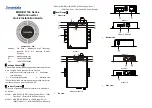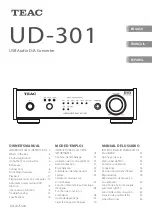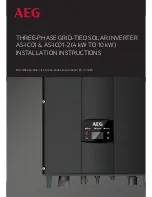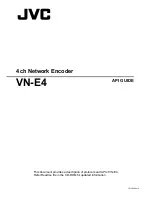
EN
FR
DE
IT
PT
GR
ES
19
Big̲PAC̲eng.indb 35
2011/02/23 13:37:56
Big̲PAC̲eng.indb 36
2011/02/23 13:37:56
37
9-21-3. Checking indoor unit addresses
Use the remote controller to check the addresses of the indoor
units. Press and hold the
button and
button for 4
seconds or longer (simple settings mode, “ALL” appears on the
remote controller). Then press the
button and select the
indoor address.
(For the system addresses of the No. 1 outdoor unit, each time the
button is pressed, the address changes as follows: 1-1, 1-2, ...)
The indoor unit fan operates only at the selected indoor unit.
Confirm the indoor unit address. (For the system addresses of
the No. 2 outdoor unit, the displayed addresses are 2-1, 2-2, ...)
Press the
button again to return to the normal remote
controller mode.
Fig. 9-18
9-21-4. Indicating (marking) the indoor and outdoor unit
combination number
Indicate (mark) the number after automatic address setting is
completed.
(1) So that the combination of each indoor unit can be easily
checked when multiple units are installed, ensure that
the indoor and outdoor unit numbers correspond to the
system address number on the outdoor unit control PCB,
and use a magic marker or similar means which cannot
be easily removed to indicate the numbers in an easily
visible location on the indoor units (near the indoor unit
nameplates).
Example: (Outdoor) 1 – (Indoor) 1
(Outdoor) 2 – (Indoor) 1
(2) These numbers will be needed for maintenance. Be sure to
indicate them.
9-22. Automatic Address Setting
9-22-1. Basic wiring diagram
●
Link wiring
N OT E
●
A terminal plug (black) is attached to each of the outdoor unit
control PCBs. At only one outdoor unit, leave the terminal
plug short-circuit socket on the “Yes” side. At all the other
outdoor units, change the socket (from “Yes” to “No”).
●
A maximum of 8 indoor units can be connected to 1 remote
controller for group control.
3-1
1-1
2-1
Fig. 9-19
Refr
iger
ant system No
. 1
Refr
iger
ant system No
. 2
Refr
iger
ant system No
. 3
(Change setting to
“1”)
(Change setting to
“2”)
(Change setting to
“3”)
Change the ter
minal
plug (b
lac
k) shor
t-
circuit soc
k
e
t
Change the ter
minal
plug (b
lac
k) shor
t-
circuit soc
k
e
t
Remote controller
Remote controller
Inter-unit control
wir
ing
No
. 1
N
o
. 2
N
o
. 3
Remote controller
Indoor unit
Outdoor unit
T
e
rminal plate 1, 2
T
e
rminal plate 1, 2
System address
rotar
y s
w
itch on the
outdoor unit PCB
Big̲PAC̲eng.indb 37
2011/02/23 13:37:57
38
9-22-2. Setting outdoor unit system addresses
For the basic wiring diagram (Set the system addresses: 1, 2, 3...)
ON
1
2
8 – 10 HP
LED1
FUSE (0.5A, F500)
OC (CN500, BLU)
MOV2
(CN301, BLK)
MOV1
(CN300, WHT)
EMG (CN502, BRN)
SILENT (CN037, WHT)
PUMP DOWN (CN048)
TEMINAL (CN205, BLK)
R.C.ADD. Rotary switch
C2 (CN020, WHT)
C1 (CN021, WHT)
TEST (CN033, RED)
TD (CN024, BLK)
TO (CN023, BLK)
TS (CN022, RED)
63PH (CN027, WHT)
EXCT
(CN030, RED)
RC P
(CN039, RED)
IC002
CTL2
(CN202, GRN)
CTL1
(CN203, GRN)
FUSE
(6.3A, F101)
N . P . C H E C K
(CN046, RED)
LED2
MODE (CN038)
D115
(Power LED)
IC001
R.C.ADD. DIP switch
A.ADD (CN047)
C-CHK (CN035)
EEPROM
LED (D041 EEPROM LED)
Fig. 9-20
System address
No.
System address 10s
digit
(2P DIP switch)
System address
1s place
(Rotary switch)
0 Automatic address
(Setting at shipment = “0”)
Both OFF
ON
ON
OFF
1
2
“0” setting
1 (If outdoor unit is No. 1)
Both OFF
ON
ON
OFF
1
2
“1” setting
9-22-3. Checking indoor unit addresses
Use the remote controller to check the addresses of the indoor
units. Press and hold the
button and
button for 4
seconds or longer (simple settings mode, “ALL” appears on the
remote controller). Then press the
button and select the
indoor address.
(For the system addresses of the No. 1 outdoor unit, each time
the button is pressed, the address changes as follows: 1-1, 1-2,
...)
The indoor unit fan operates only at the selected indoor unit.
Confirm the indoor unit address.
Press the
button again to return to the normal remote
controller mode.
Fig. 9-21
9-22-4. Indicating (marking) the indoor and outdoor unit
combination number
Indicate (mark) the number after automatic address setting is
completed.
(1) So that the combination of each indoor unit can be easily
checked when multiple units are installed, ensure that
the indoor and outdoor unit numbers correspond to the
system address number on the outdoor unit control PCB,
and use a magic marker or similar means which cannot
be easily removed to indicate the numbers in an easily
visible location on the indoor units (near the indoor unit
nameplates).
Example: (Outdoor) 1 – (Indoor) 1
(Outdoor) 2 – (Indoor) 1
(2) These numbers will be needed for maintenance. Be sure to
indicate them.
Outdoor unit control PCB
System address rotary switch
System address rotary switch
(Set to “0” at time of shipment)
System address
10s 20s DIP switch
ON
OFF
Big̲PAC̲eng.indb 38
2011/02/23 13:37:57
B
ig
̲P
A
C
̲e
n
g
̲m
en
tu
k
e.i
n
d
d
1
9
Big̲PAC̲eng̲mentuke.indd 19
2
0
1
1
/0
2
/2
3
1
3
:4
3
:4
3
2011/02/23 13:43:43
Summary of Contents for U-200PE1E8
Page 2: ......
Page 24: ... NOTE EN FR DE IT PT GR ES 22 ...
Page 46: ... NOTE 44 GB FR DE IT PT GR ES SUPPLEMENT ...
Page 68: ... ANMERKUNGEN 66 GB FR DE IT PT GR ES SUPPLEMENT ...
Page 90: ... PROMEMORIA 88 GB FR DE IT PT GR ES SUPPLEMENT ...
Page 112: ...EN FR DE IT PT GR ES 110 NOTAS ...
Page 134: ... Σημεıωματάριο 132 GB FR DE IT PT GR ES SUPPLEMENT ...
Page 156: ...EN FR DE IT PT GR ES 154 NOTAS ...
Page 157: ......
















































